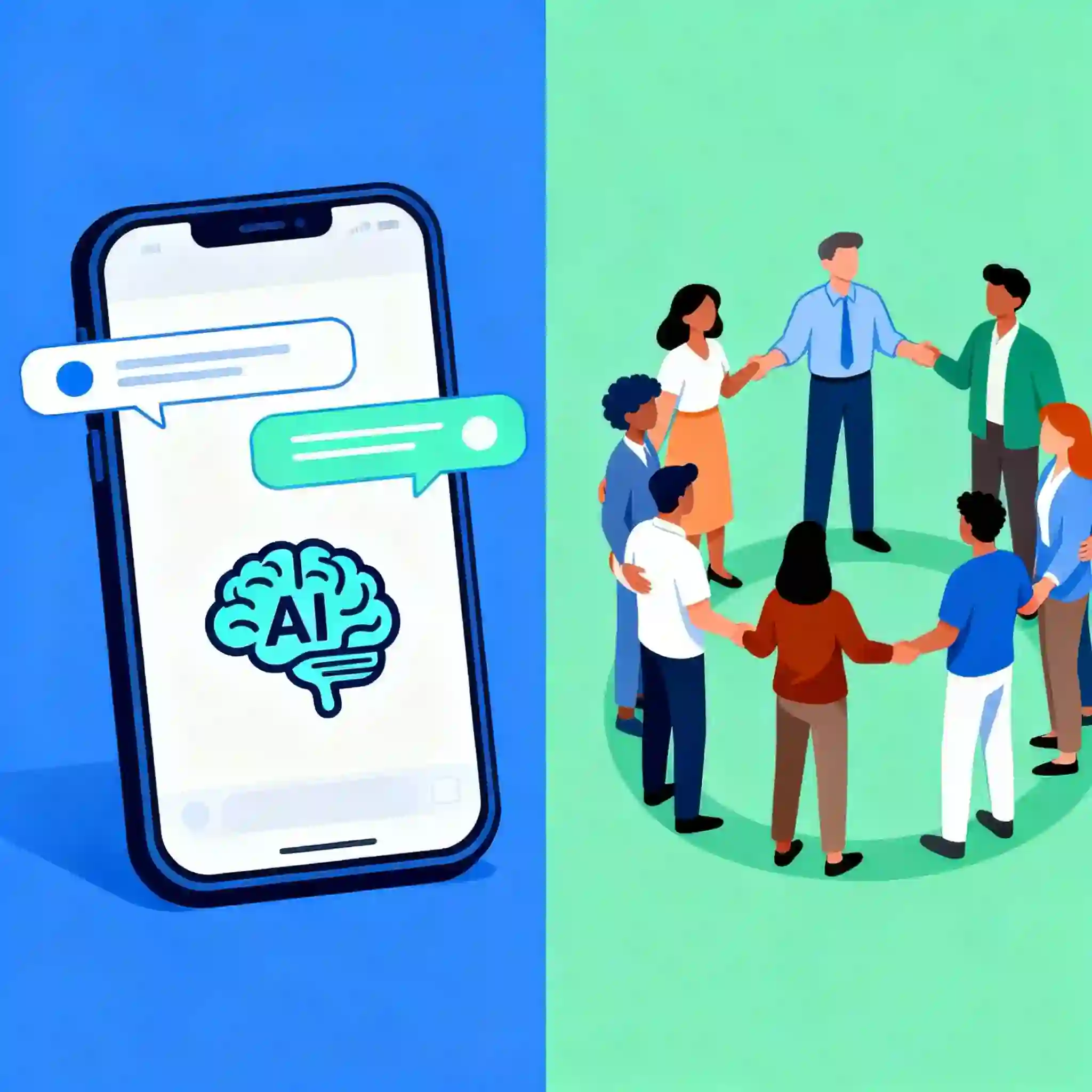TL;DR: Understanding Interpersonal Therapy (IPT)
Definition: Interpersonal Therapy (IPT) is a time-limited, evidence-based psychotherapy that treats depression by improving interpersonal relationships and social functioning. Core Focus: IPT addresses four key problem areas: grief/loss, role disputes, role transitions, and interpersonal deficits. Effectiveness: Research shows IPT achieves large effect sizes for depression (-1.48) with 97% session attendance rates and sustained improvements at 3-month follow-up. Treatment Structure: Typically 12-16 sessions organized in three phases: assessment, active treatment, and termination with relapse prevention.
In the landscape of mental health treatment, Interpersonal Therapy (IPT) stands as one of the most rigorously tested and effective approaches for addressing depression and mood disorders. Developed in the 1970s by Gerald Klerman and Myrna Weissman, IPT operates on a fundamental principle: our mental health is intimately connected to the quality of our relationships and social interactions.
Unlike therapies that delve extensively into childhood experiences or unconscious conflicts, IPT focuses squarely on present-day relationships and the interpersonal challenges that contribute to psychological distress. This approach recognizes that while we cannot change the past, we can transform how we navigate current relationships—and in doing so, dramatically improve our mental well-being.
The Core Philosophy of IPT: Relationships as Medicine
Understanding the Connection Between Mood and Relationships
IPT is built upon a scientifically-supported understanding that our emotional states and interpersonal relationships exist in a continuous cycle of mutual influence. When relationships become strained, conflicted, or absent, our mental health suffers. Conversely, when we experience depression or anxiety, our capacity for healthy relationships diminishes, creating a self-perpetuating cycle of distress.
Research consistently demonstrates that people with strong, supportive relationships experience:
- 50% lower rates of depression compared to socially isolated individuals
- Faster recovery times from mental health episodes when social support is present
- Greater resilience to life stressors and traumatic events
- Improved treatment outcomes across all therapeutic modalities
The Four Pillars of IPT Problem Areas
IPT organizes treatment around four specific interpersonal problem areas that commonly contribute to depression and mood disorders:
Grief and Loss: Processing the death of loved ones, relationship endings, or other significant losses that disrupt social support systems and trigger depressive episodes.
Role Disputes: Addressing conflicts with important people in your life—spouses, family members, friends, or colleagues—where expectations, needs, or values clash and create ongoing stress.
Role Transitions: Navigating major life changes such as marriage, divorce, parenthood, retirement, job changes, or moves that require adaptation to new social roles and relationships.
Interpersonal Deficits: Developing skills for initiating, maintaining, and deepening relationships when social anxiety, communication difficulties, or past experiences have created barriers to connection.
How Interpersonal Therapy Works: The Three-Phase Structure
Phase 1: Assessment and Problem Identification (Sessions 1-3)
The initial phase focuses on comprehensive assessment of your interpersonal world and symptom presentation. During this foundation-building period, your therapist will:
Conduct an Interpersonal Inventory: This detailed exploration maps your most significant relationships, identifying patterns, conflicts, and sources of support or stress.
Link Symptoms to Interpersonal Issues: Together, you'll discover connections between your mood symptoms and specific relationship challenges or changes.
Establish Treatment Goals: Based on the assessment, you'll collaboratively identify 1-2 primary problem areas to focus on during treatment.
Provide Psychoeducation: You'll learn about depression, its interpersonal components, and how IPT can help break negative cycles.
Phase 2: Active Treatment (Sessions 4-12)
The middle phase constitutes the heart of IPT work, where specific techniques address your identified problem areas:
Communication Analysis: Your therapist helps you examine communication patterns within relationships, identifying what works well and what creates conflict or misunderstanding.
Role-Playing and Rehearsal: You'll practice difficult conversations, assertiveness skills, or conflict resolution strategies in the safety of the therapeutic relationship.
Decision Analysis: When facing interpersonal dilemmas, you'll explore all available options and develop strategies for achieving desired outcomes.
Emotional Processing: IPT encourages full expression and validation of feelings related to relationship issues, helping you communicate emotions more effectively.
Phase 3: Termination and Maintenance (Final Sessions)
The concluding phase prepares you for sustained improvement beyond therapy completion:
Progress Review: You and your therapist will evaluate improvements in both symptoms and relationships.
Relapse Prevention Planning: Together, you'll identify warning signs and develop strategies for managing future interpersonal challenges.
Skill Consolidation: Key techniques and insights will be reinforced to support independent problem-solving.
Transition Planning: If additional support is needed, you'll plan for maintenance sessions or referrals.
Evidence-Based Effectiveness: What Research Shows
Clinical Trial Outcomes
Extensive research demonstrates IPT's effectiveness across diverse populations and settings:
Depression Treatment: Meta-analyses show large effect sizes (d = -1.48) for depression symptom reduction, with improvements sustained at long-term follow-up.
International Validation: Studies across China, Kenya, Lebanon, and Nepal consistently demonstrate significant improvements in depression scores and social functioning.
High Engagement: Research reveals exceptionally low dropout rates (4%) and high session attendance (97%), indicating strong patient acceptance and therapeutic alliance formation.
Cost-Effectiveness: Economic analyses show benefit-to-cost ratios of 3.2:1 for IPT, with participants gaining significant income increases through improved productivity.
Comparative Effectiveness
Studies comparing IPT to other evidence-based treatments reveal:
- Equivalent effectiveness to CBT for depression treatment, with some patients showing preferences for IPT's relationship focus
- Superior to medication alone for long-term symptom management and relapse prevention
- Enhanced outcomes when combined with medication for severe depression cases
- Particularly effective for depression with interpersonal triggers or relationship-focused presentations
Special Population Success
IPT demonstrates remarkable adaptability across diverse groups:
Adolescents: IPT for Adolescents (IPT-A) shows large improvements in depression symptoms with particularly strong outcomes for girls and older adolescents who benefit from group support.
Postpartum Depression: Group IPT significantly improves maternal depression and child developmental outcomes, making it a WHO-recommended intervention.
Cultural Adaptations: Successful implementations in China, Africa, and other regions demonstrate cross-cultural effectiveness when culturally adapted while maintaining core IPT principles.
Key IPT Techniques and Strategies
Communication Analysis: Transforming Interaction Patterns
Communication analysis forms the backbone of IPT intervention, helping you understand and improve how you express needs, emotions, and boundaries. This technique involves:
Detailed Exploration: Your therapist will ask for "movie scripts" of important conversations, examining content, tone, nonverbal communication, and emotional context.
Intent vs. Impact Assessment: You'll explore what you intended to communicate versus what was actually received, identifying disconnects that create conflict.
Skill Building: Through practice and feedback, you'll develop more effective ways to express yourself, listen actively, and navigate difficult conversations.
Role-Playing and Behavioral Rehearsal
IPT uses experiential techniques to build confidence and skills for real-world relationship challenges:
Conflict Resolution Practice: You'll rehearse difficult conversations with family members, partners, or colleagues before having them in real life.
Assertiveness Training: Through role-play, you'll practice setting boundaries, expressing needs, and advocating for yourself respectfully.
Social Skills Development: For those with interpersonal deficits, role-playing provides safe practice for initiating conversations, expressing emotions, and building connections.
Grief Work and Loss Processing
For individuals dealing with loss, IPT provides structured approaches to grief processing:
Emotional Expression: Facilitating full expression of grief-related emotions without judgment or pressure to "move on" quickly.
Memory Integration: Helping you develop a balanced view of the lost relationship that acknowledges both positive and negative aspects.
Social Network Rebuilding: Supporting the development of new relationships and support systems to fill gaps left by loss.
Decision Analysis and Problem-Solving
IPT empowers you to make informed decisions about relationship challenges:
Option Generation: When facing interpersonal dilemmas, you'll explore all possible responses and their potential consequences.
Resource Assessment: Identifying strengths, supports, and resources available to help you achieve desired outcomes.
Implementation Planning: Developing step-by-step strategies for addressing relationship problems or life transitions.
Who Benefits Most from IPT?
Primary Indications
IPT demonstrates strongest evidence for several specific conditions:
Major Depressive Disorder: IPT is recommended as first-line treatment by multiple clinical guidelines, particularly when depression has clear interpersonal triggers or components.
Dysthymia and Persistent Depression: The relationship focus helps address chronic patterns of interpersonal difficulty that maintain long-term depression.
Postpartum Depression: IPT's attention to role transitions and social support makes it ideally suited for new mothers navigating identity and relationship changes.
Bipolar Disorder: During depressive episodes, IPT can help stabilize relationships and improve social support without triggering mania.
Secondary Applications
Research supports IPT effectiveness for additional conditions:
Anxiety Disorders: Particularly social anxiety and generalized anxiety with strong interpersonal components respond well to IPT.
Eating Disorders: IPT addresses relationship patterns that often maintain disordered eating behaviors, showing particular success with bulimia nervosa.
PTSD: When trauma has interpersonal elements or has damaged relationships, IPT can help restore social connection and support.
Substance Use Disorders: IPT addresses relationship triggers for substance use and helps rebuild healthy social networks supporting recovery.
IPT Adaptations and Modern Applications
Group IPT: Harnessing Collective Healing
Group Interpersonal Therapy leverages peer support for enhanced therapeutic outcomes:
Shared Problem Areas: Group members often share similar interpersonal challenges, providing mutual understanding and validation.
Real-Time Practice: The group setting provides immediate opportunities to practice new interpersonal skills with supportive peers.
Cost-Effective Delivery: Group formats make evidence-based IPT accessible to larger numbers of people at reduced cost.
Research-Supported Outcomes: Studies show equivalent or superior outcomes compared to individual IPT for many conditions.
Digital IPT and Technology Integration
Modern technology enhances IPT accessibility and effectiveness:
Online Delivery: Video-based IPT maintains therapeutic effectiveness while improving access for remote or mobility-limited individuals.
Mobile Applications: Smartphone apps can provide between-session support for communication practice, mood tracking, and skill reinforcement.
AI Integration: Platforms like Noah AI can deliver IPT-informed support, helping users practice communication skills and process interpersonal challenges 24/7.
IPT vs. Other Therapeutic Approaches
IPT vs. Cognitive Behavioral Therapy (CBT)
While both are evidence-based treatments, IPT and CBT differ in focus and approach:
Research suggests that some individuals may respond better to IPT's relationship focus, particularly those with:
- Clear interpersonal triggers for depression
- Strong preference for exploring emotions and relationships
- Limited insight into automatic thoughts or cognitive patterns
- Cultural backgrounds that emphasize relational rather than individual approaches
IPT vs. Psychodynamic Therapy
IPT shares some similarities with psychodynamic approaches but maintains important distinctions:
Similarities: Both emphasize relationships, emotional expression, and the therapeutic alliance as healing agents.
Key Differences: IPT is time-limited, present-focused, and directive, while psychodynamic therapy is typically longer-term, explores unconscious patterns, and is less structured.
Practical Advantages of IPT: The structured, problem-focused approach makes IPT more accessible and provides clearer treatment goals and timelines.
The Future of IPT: Innovation and Integration
Cultural Adaptations and Global Expansion
IPT's effectiveness across diverse cultures suggests universal relevance of interpersonal approaches to mental health:
Cultural Modification Research: Studies in China, Africa, and other regions are identifying optimal adaptations while preserving core therapeutic mechanisms.
Training and Dissemination: WHO and other organizations are promoting IPT training in resource-limited settings as a scalable mental health intervention.
Technology-Enhanced Delivery: Digital platforms are making culturally adapted IPT accessible to underserved populations globally.
Integration with Modern Mental Health Care
IPT increasingly integrates with comprehensive mental health approaches:
Stepped Care Models: IPT serves as an intermediate intervention between self-help and intensive therapy, providing structured support for moderate depression.
Collaborative Care: IPT therapists work within multidisciplinary teams including psychiatrists, primary care providers, and social workers for comprehensive treatment.
Preventive Applications: IPT-based programs for at-risk individuals can prevent depression development during vulnerable life transitions.
Frequently Asked Questions
How long does IPT take to work?
Most people begin experiencing improvements within 4-6 sessions, with significant changes typically evident by session 8-10. The full 12-16 session protocol ensures sustained improvement and skill consolidation for long-term success.
Can IPT be done online or through apps?
Yes, research supports the effectiveness of online IPT delivery. Digital platforms can provide valuable between-session support, though the relationship-focused nature of IPT often benefits from face-to-face interaction when possible.
Is IPT effective for relationship problems or just individual depression?
IPT addresses both individual symptoms and relationship difficulties simultaneously. Many people experience improvements in both depression and relationship satisfaction, as the two are interconnected.
How does IPT differ from couples or family therapy?
IPT focuses on one individual's relationships and interpersonal patterns, while couples/family therapy involves multiple participants working on shared relationship dynamics. IPT can complement couples therapy or serve as preparation for it.
Can IPT help with anxiety disorders?
Yes, IPT shows effectiveness for anxiety disorders, particularly when anxiety has strong interpersonal components like social anxiety or generalized worry about relationships.
What if I don't have clear relationship problems?
IPT's "interpersonal deficits" focus area specifically addresses difficulty forming or maintaining relationships. The therapy can help you develop skills for building meaningful connections even if current relationships seem adequate.
Conclusion: The Power of Interpersonal Connection in Healing
Interpersonal Therapy represents a fundamental recognition that human beings are inherently social creatures whose mental health depends significantly on the quality of our relationships and social connections. Through its structured, time-limited approach, IPT offers hope for millions struggling with depression, anxiety, and other mental health challenges.
The extensive research base—including studies across diverse cultures, age groups, and settings—demonstrates that focusing on interpersonal relationships can create profound changes in mental health symptoms. With large effect sizes, high patient satisfaction, and sustained improvements, IPT stands as one of our most effective evidence-based treatments.
As we look toward the future, technology platforms like Noah AI are making IPT principles more accessible than ever before. While maintaining the core focus on relationships and interpersonal skill development, digital delivery can provide immediate support, practice opportunities, and skill reinforcement that enhance traditional therapy outcomes.
The beauty of IPT lies in its fundamental optimism: relationships that have been sources of pain can become sources of healing. By improving how we communicate, navigate conflicts, process losses, and build connections, we not only alleviate current symptoms but develop resilience for future challenges.
IPT reminds us that healing happens in relationship—whether with a human therapist, a supportive AI companion, or the important people in our daily lives. In our increasingly connected yet often lonely world, the interpersonal approach offers a pathway back to the human connections that nurture mental health and support flourishing.
Ready to explore how interpersonal therapy can support your mental health journey? Discover how Noah AI incorporates IPT principles to provide 24/7 support for relationship challenges, communication skills, and emotional processing—because better relationships lead to better mental health.
Download the Noah AI app for iPhone and Android today.
References
- Implementation of group interpersonal therapy to treat depression in people living with HIV: A first evaluation of IPT dissemination in Senegal
https://www.cambridge.org/core/product/identifier/S2054425125100290/type/journal_article - Interpersonal Psychotherapy (IPT) – Cleveland Clinic
https://my.clevelandclinic.org/health/treatments/interpersonal-psychotherapy-ipt - Interpersonal Psychotherapy for Patients with Mental Disorders – PMC
https://www.ncbi.nlm.nih.gov/pmc/articles/PMC7001362/ - Key IPT Strategies – International Society of Interpersonal Psychotherapy (ISIPT)
https://interpersonalpsychotherapy.org/ipt-basics/key-ipt-strategies/ - Techniques of Interpersonal Therapy – Latrina Walden Exam Solutions
https://shop.latrinawaldenexamsolutions.com/blogs/pmhnp/techniques-of-interpersonal-therapy - Exploring context, mechanisms and outcomes in group interpersonal therapy for adolescents with depression in Nepal: a qualitative realist analysis
https://www.cambridge.org/core/product/identifier/S2056472425101610/type/journal_article - Protocol for the economic evaluation of group interpersonal therapy for postnatal depression compared with high-quality standard care in Kenya and Lebanon (SUMMIT trial)
https://openresearch.nihr.ac.uk/articles/5-17/v1 - The effectiveness of interpersonal psychotherapy for adolescents – PubMed
https://pubmed.ncbi.nlm.nih.gov/32677350/ - Mechanisms of Change in Interpersonal Therapy (IPT) – PMC
https://www.ncbi.nlm.nih.gov/pmc/articles/PMC4109031/ - Interpersonal Therapy Techniques – YouTube
https://www.youtube.com/watch?v=FqCifogGdkE - Characterizing Therapy Experiences in Youth With Depression and Suicide via the Depression Treatment Experiences Questionnaire
https://onlinelibrary.wiley.com/doi/10.1002/cpp.70088 - Cost-Benefit Analysis of Interpersonal Therapy and Fluoxetine for Treating Depression and PTSD in Primary Care Settings in Kenya
https://www.researchsquare.com/article/rs-6977800/v1 - Costs analysis of integrating group interpersonal therapy into HIV care services in Senegal
https://ijmhs.biomedcentral.com/articles/10.1186/s13033-024-00654-6 - The effectiveness of individual interpersonal psychotherapy as a treatment for depression – PMC
https://www.ncbi.nlm.nih.gov/pmc/articles/PMC3558333/







